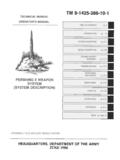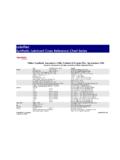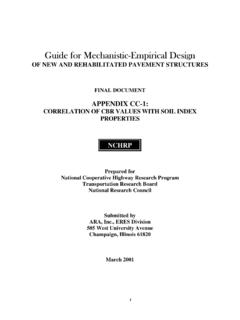Transcription of Heat Release Rates of Burning Items in Fires
1 (c)2000 American Institute of Aeronautics & Astronautics or published with permission of author(s) and/or author(s) sponsoring organization. A004 6576 AIAA 2000-0722 heat Release Rates OF Burning Items IN Fires HYEONG-JIN KIM and DAVID G. LILLEY Lilley & Associates Route 1 Box 151 Stillwater, OK 74074 38th Aerospace Sciences Meeting & Exhibit lo-13 January 2000 / Reno, NV For permission to copy or republish, contact the American Institute of Aeronautics and Astronautics 1801 Alexander Bell Drive, Suite 500, Reston, VA 20191 (c)2000 American Institute of Aeronautics & Astronautics or published with permission of author(s) and/or author(s) sponsoring organization. HEATRELEASERATESOF Burning Items IN Fires HyeongJin Kim* and David G. Lilley** Lilley & Associates Route 1 Box 151 Stillwater, OK 74074 ABSTRACT heat Release Rates of typical Items in Fires are needed as a prerequisite for estimating fire growth and temperatures in structural Fires .
2 That is, these Burning Rates are required to be specified by the user as input to single-room and multi-room structural fire computer codes like FPETool, FASTLite and HAZARD. Data are given here that permit Burning Items to be specified in a useful modeled way, taking a t*-fire for the growth and decay periods, with a constant maximum heat Release rate between these two periods. INTRODUCTION Computer codes are available that permit calculations to be made of the effect of a given specified fire on the subsequent environment in a structural fire. Things like temperature of the smoke layer, its depth from the ceiling downwards, its optical density, ceiling, wall and floor temperatures, floor surface heat flux rate, etc are calculated a a function of time in all the rooms of a typical multi-room structural fire. However, the accuracy of these calculations is strongly dependent upon the correctness of the initial fire specifications.
3 heat Release Rates of typical Items in tires are needed as a prerequisite for estimating fire growth and temperatures in structural tires. That is, these Burning Rates are required to be specified by the user as input to single- room and multi-room structural tire computer codes like FPETool, FASTLite and HAZARD, see Bukowski et al (1989), Peacock et al (1994), and Portier et al (1996). Data are given here that permit Burning Items to be specified in a useful modeled way, taking a t2-fire for the growth and decay periods, with a constant maximum heat Release rate between these two periods. A vast range of many Items are considered. Detailed tabulation and graphic display of the parameters (for each item during experimental bums) permits fire modelers to initiate calculations. Further knowledge enables the deduction of when second and subsequent Items may become involved, whether flashover may occur, and when conditions may become untenable.
4 Thus, it is clear that many important phenomena that are calculated in Fires depend on the quality and accuracy of the initial bum specification. FUNDAMENTALS Typically, the heat Release rate ( heat energy evolving on a per unit time basis) of a fire 0 (kW) changes as the size of the fire changes, as a function of time t (seconds) after fire ignition. That is, the variation of G versus t is extremely important in characterizing the rate of growth of a fire. Data are available for heat Release rate vs. time for many Items , see for example Babrauskas and Grayson (1992), SFPE (1995) and the data base in Bukowski et al. (1989). Furniture calorimeter and cone calorimeter measurements are available, with data specifically for: Pools, liquid or plastic Cribs (regular array of sticks) Wood pallets Upholstered furniture Mattresses Pillows Wardrobes (closets) Television sets Christmas trees * Member AIAA ** Professor, Fellow AIAA Copyright 1999 by D.
5 G. Lilley. All rights reserved Published by AIAA with permission. (c)2000 American Institute of Aeronautics & Astronautics or published with permission of author(s) and/or author(s) sponsoring organization. Curtains (drapes) Electric cable trays Trash bags and containers Industrial rack-stored commodities Notice that although data may well be available from careful laboratory experiments, the data may not apply directly to real-world fire situations. The laboratory data does not usually take into account the enhancement of Burning Rates because of radiation feedback. Full-scale timiture calorimeter tests give useful information on the Burning Rates of many typical household Items . Peak heating values are particularly useful to know, since in some cases a triangular heat Release rate vs. time representation can be utilized for simplicity. Upholstered furniture - wood frame, with fire- retardant polyurethane padding and olefin cover fabric - show peak heat Release Rates as follows: F21 Chair 2100 kW at 260 s F3 1 Loveseat 2886 kW at 230 s F32 Sofa 3120 kW at 215 s The F number used here corresponds to the particular experiment performed, see Bukowski (1989).
6 Other useful peak heat Release Rates : Mattress and boxspring 660 kW at 910 s Curtain, cotton, kg 240 kW at 175 s Wastepaper basket, kg 15kW at 350 s Television, kg 290 kW at 670 s Cooking oil, corn, cottonseed, etc. 12-inch pan Christmas tree, spruce, 7 kg 116kW constant 650 kW at 350 s and the values help to visualize the differences between the Items under Burning conditions. Of special concern in fire investigation and computer reconstruction of building Fires is the use of accelerants. Liquid fuels are often preferred. They are used to accelerate the development of the fire, as indicated by temperature and spreading Rates . On the practical investigative side, features often include: low bums, high temperatures at low hidden locations, rapid house fire development, and particular flame and smoke colors seen by witnesses. Burning Rates of liquid pool Fires are available in SFPE (1995): POOL Fires The thermal radiation hazards from hydrocarbon spill Fires depend on a number of parameters, including the composition of the hydrocarbon, the size and shape of the fire, the duration of the fire, its proximity to the object at risk, and the thermal characteristics of the object exposed to the fire.
7 The state of the art of predicting the thermal environment of hydrocarbon spill Fires consists essentially of semiempirical methods, some of which are based on experimental data from small- and medium-scale tests. Needless to day, such semiempirical methods are always subject to uncertainties when experimental data from small-scale Fires are extrapolated to predict the thermal properties of very large-scale Fires . A systematic study of liquid hydrocarbon pool Fires over the widest range of pool diameters was conducted by Blinov and Khudiakov. Gasoline, tractor kerosene, diesel oil, and solar oil (and, to a limited extent, household kerosene and transformer oil) were burned in cylindrical pans (depth not indicated) of diameters cm to meters. Liquid Burning Rates and flame heights were measured, and visual and photographic observations of the flames were recorded. Hottel plotted these data and the results are shown in the Figure.
8 The lower curve of this figure shows the variation of Burning velocity (in meters/second of depth Burning ) as a function of the pan diameter. The upper curves give the ratio of flame height to flame diameter as a function of the pan diameter. The diagonal lines on the lower curves represent lines of constant Reynolds numbers, based on pan diameter. Useful information about the rate of Burning of pool Fires is readily available in Tables, see SFPE (1995) for example, via the mass consumed per unit area per unit time . From the energy per unit mass values also given, one can readily compute the heat Release rate 0 in kW, or in Btu per hour since 100,000 Btuihr = 1 kW. It may be nored that for pool diameters less than 1 meter, the Burning rate expression is reduced because of a reduction in radiation feedback. THE t2-FIRE GROWTH MODEL Emphasis is often placed on the growth phase of the fire. Slow, medium, fast and ultra-fast fire growths may be specified by the t2-fire growth model, where, after an initial incubation period, Q = af(t - to)2 where af is a fire-growth coefficient (kW/s2) and to is the length of the incubation period (s).
9 The coeficient af appears to lie in the range 10s3 kW/s2 for ,very slowly developing tires to I kW/s2 for very fast fire growth. The incubation period (to) will depend on the nature of the ignition source and its location, but data are now becoming aiailable (see Babrauskas) on fire growth Rates on single Items of fiuniture (upholstered chairs, beds, etc.) which may be quantified in these terms. Suggested values for the coefficient gf are also given in the formula section of Makefre - a subset of the FPETool Computer Program. The specification there for the fire-growth coefficient af (kW/s ) is: Slow Medium kW/s kW/s 2 (c)2000 American Institute of Aeronautics & Astronautics or published with permission of author(s) and/or author(s) sponsoring organization. Fast kW/Z Ultra-fast kW/s= and these correspond to growth times of the tire 6om zero size to 1 MW total heat output in Slow 600 seconds Medium 300 seconds Fast 150 seconds Ultra-fast 75 seconds Burning Rates OF TYPICAL Items Experimental data are available for a variety of Items , giving heat Release rate Q (kW) vs time (seconds).
10 Each of these graphs is in conformity with several parameters that comnletely characterize the situation, as given in Figure 1: to tl MW t Qo td t end G time to the onset of ignition time to reach 1 MW level-off time time at which 0 decay begins time at which Q equals zero growth time = t, MW - t, Notice that both the ascent and decent are characterized by t*-tire activity: ($ =a,t*wheret=t-t, 0 = adt2 where t = tend - t where ag and ad are the fire-growth and fire-decay coefficients (kW/s*), respectively. These heat Release Rates G (in kW) vs time t (in seconds) are active only in the growth (to I t I t tQ,) and decay (td 5 t I tend), respectively. The rfIaXimUm heat Release rate o,, (kW) occurs when tp,, I t I td. The growth time to reach 1 MW = 1,000 kW of heat Release rate G is t, MW - t, seconds, and this is related to the fire- growth parameter ag (kW/s*) via ag = 1000 / (tl MW - to)*. Simularly the tire-decay parameter ad (kW/s ) is found via ad = Q m&end - td)*.






